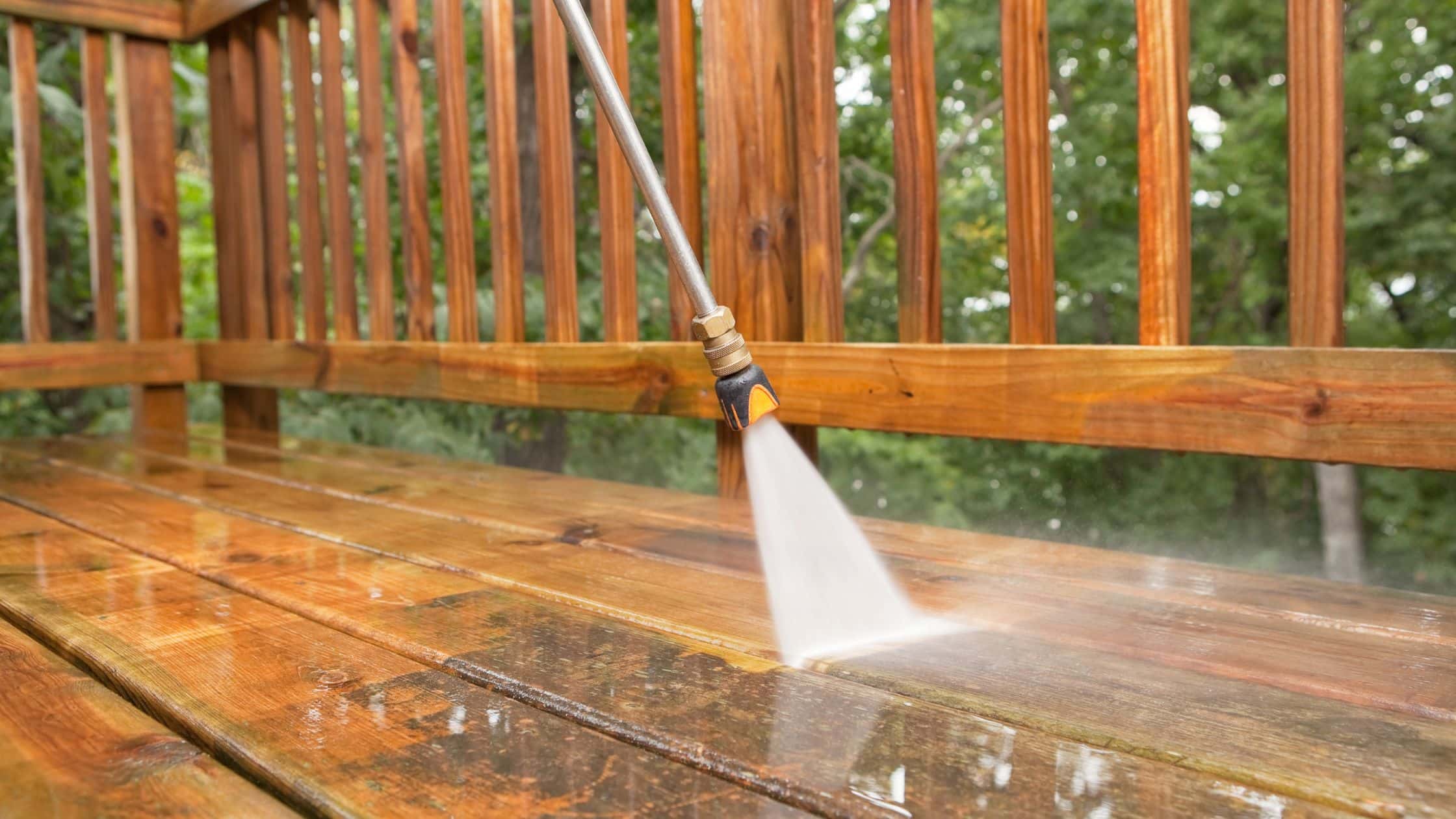
Do You Need to Power Wash a Deck Before Staining?
Power washing isn’t always required before staining a deck — but proper cleaning absolutely is. The goal is to remove dirt, mold, old stain, and mill glaze so the new stain bonds properly. Whether you use a pressure washer, deck cleaner, or both depends on your deck’s condition.
Do You Need to Power Wash a Deck Before Staining?
A lot of homeowners ask us this question before a staining project — and the answer isn’t as simple as “yes” or “no.” While a clean deck is non-negotiable, how you clean it depends on the condition of the wood, the type of stain you’re using, and how long it’s been since the last treatment.
If you skip this step (or do it wrong), your stain may not soak in — and could peel, fade, or fail within a season. Let’s walk through when to pressure wash, when not to, and what alternatives give the best results.
🧼 Why Decks Must Be Clean Before Staining
Whether you’re using a clear sealer or a solid stain, the product needs to soak into the wood grain. Dirt, algae, old finish, and weathered wood fibers all block that absorption.
If you stain without cleaning:
-
-
- The finish may peel or flake quickly
-
- Water won’t bead — stain won’t protect
- Mold or mildew will keep growing underneath
-
🧠 Bottom line: The cleaner the surface, the longer your stain will last. Clean wood = better bond = longer life.
💦 When You Should Power Wash
Power washing can save time if your deck meets certain conditions:
✅ Best candidates for pressure washing:
-
-
- Heavily soiled or moldy decks
-
- Decks with thick, flaking, or peeling old stain
-
- Weathered wood with deep grain texture
- High-traffic decks with lots of grime or pollen buildup
-
What it does well:
-
-
- Strips off dirt and mildew fast
-
- Removes loose stain
- Roughens slick mill glaze on newer wood
-
⚠️ Use caution: High pressure can gouge or damage wood if done carelessly. Always use a fan tip and keep the nozzle moving at 500–1200 PSI max for wood decks.
🚫 When NOT to Pressure Wash a Deck
Power washing is not always the best choice — especially if:
-
-
- The deck boards are soft or splintering
-
- You have new wood that still has its factory coating
-
- You’re planning to use a transparent stain, which shows imperfections
- You don’t have experience using a washer correctly
-
Risks of overdoing it:
-
-
- Raised grain or “furry” wood
-
- Water damage or moisture trapped in boards
- Need for extra sanding to fix surface texture
-
🪚 In many cases, we skip power washing and opt for a safer, more controlled method using a deck cleaner, scrub brush, and rinse.
🧪 How We Clean Decks Before Staining
Every deck is different, so we start by inspecting the condition of your boards. From there, we choose the best prep method for long-term success:
🧴 Option 1: Deck Cleaner + Scrub
We apply a biodegradable cleaner, scrub with a stiff brush, and rinse with a hose — no pressure washer needed. Great for newer decks or routine maintenance coats.
💨 Option 2: Light Pressure Wash + Dry
When decks have years of grime or thick stain buildup, we gently pressure wash — then let the deck dry 48–72 hours before staining.
🔧 Option 3: Sanding or Spot Prep
If mill glaze is present (common on new wood), or if pressure washing raised the grain, we’ll sand key areas to ensure smooth absorption.
✅ Our Rule: We never stain a deck unless it passes the water bead test — if water soaks in, we’re good to go. If not, more prep is needed.
🕓 How Long After Cleaning Can You Stain?
This depends on the weather and your cleaning method:
| Cleaning Method | Wait Time Before Staining |
|---|---|
| Pressure Wash | 48–72 hours (wood must fully dry) |
| Cleaner + Rinse | 24–48 hours |
| Hand Sand Only | 0–24 hours (as needed) |
🌧️ Important: If it rains after cleaning but before staining, restart the clock — the wood needs to dry again before you stain.
👷 Why This Matters for Our Clients
Many of the stain jobs we’re hired to fix were done too fast — a quick power wash in the morning, stain by afternoon. That looks fine on day one, but you’ll be redoing it in a year or less.
At Colin Can Help, we take our time to do it right:
-
-
- We inspect your deck for damage, grime, or bad stain
-
- Choose the safest and most effective cleaning method
-
- Let the deck fully dry before staining
- Always brush or roll the stain in for deep, even coverage
-
🛠️ We don’t just “spray and walk away.” We build protection that lasts.
🧠 FAQ
Q: Can I use a hose and a broom instead of a power washer? Yes, you can — and in some cases, it’s actually the better choice. While a power washer is faster for heavy grime or thick stain buildup, using a hose, deck cleaner, and a stiff-bristle broom or scrub brush is often gentler and safer — especially on older, softer, or pressure-treated wood. Scrubbing by hand lets you focus on trouble spots without the risk of gouging the wood or forcing water deep into the grain, which can delay staining and even cause long-term damage.
It takes more elbow grease, but this method can be just as effective when combined with the right cleaner and drying time, avoids over saturating the wood, reduces the risk of splintering or raised grain, and is safer on newer or more delicate boards.
Q: Should I sand my deck before staining?
Q: How do I know if my deck is clean enough to stain? You can test your deck’s readiness by doing a simple water test: sprinkle a few drops of water on the surface. If it soaks in quickly, the wood is clean and ready to accept stain. If it beads up or sits on the surface, there’s likely still dirt, sealer, or mill glaze preventing proper absorption. Visually, the deck should look consistent in color, free from mildew, dirt, or patches of gray wood. The surface should feel dry and solid, not fuzzy, slick, or damp. If you rub your hand across the boards and pick up dust, fuzz, or grime, more prep is needed before staining.
Q: What happens if I stain while the deck is still damp? Staining a damp deck can lead to a range of problems, from uneven color to peeling, bubbling, or complete stain failure. When wood is wet, it can’t properly absorb the stain, which means the product sits on the surface instead of soaking in and bonding. This often results in a blotchy finish that doesn’t cure correctly and may start to flake or wear off within months. Even if the stain looks decent at first, it won’t last long. That’s why we always check moisture levels and allow the deck to fully dry—usually 24 to 72 hours after washing or rain—before applying any stain.
Q: Do you include cleaning in your deck staining service? Yes, cleaning is always included in our deck staining service. Proper surface prep is the most important part of any stain job, and we never skip it. Depending on the condition of your deck, we’ll either pressure wash it using low pressure or apply a deck cleaner and scrub by hand to remove dirt, mildew, and old stain residue. Once it’s clean, we allow enough drying time before applying stain to ensure a long-lasting finish. You’ll never get a rushed or one-size-fits-all approach—we match the cleaning method to your deck’s specific needs.




No Comments
Sorry, the comment form is closed at this time.